Nonwoven Filter Media Market Research, 2032
The global nonwoven filter media market was valued at $7.4 billion in 2022, and is projected to reach $13.7 billion by 2032, growing at a CAGR of 6.5% from 2023 to 2032.
Report Key Highlighters:
- Quantitative information mentioned in the global nonwoven filter media market includes the market numbers in terms of value ($Million) and volume (Kilotons) with respect to different segments, pricing analysis, annual growth rate, CAGR (2023-32), and growth analysis.
- The analysis in the report is provided on the basis of form, manufacturing technology, and application. The study will also contain qualitative information such as the market dynamics (drivers, restraints, opportunities), Porter’s Five Force Analysis, key regulations across the region, and value chain analysis.
- A few companies, including 3M, Johns Manville, Sandler AG, Berry Global Inc., Kimberly-Clark Worldwide, Inc., Park Industries, Glatfelter Corporation, Ahlstrom, hold a large proportion of the nonwoven filter media market.
- This report makes it easier for existing market players and new entrants to the nonwoven filter media business to plan their strategies and understand the dynamics of the industry, which ultimately helps them make better decisions.
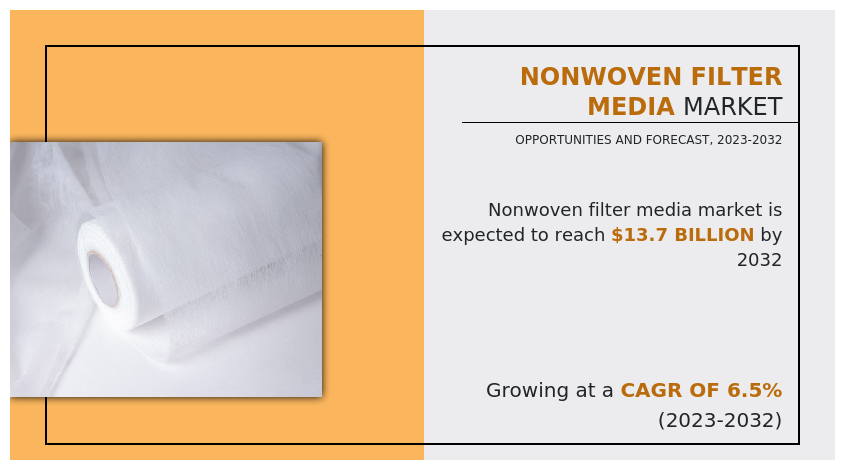
Nonwoven filter media are porous materials designed for the separation of solid particles from fluids (liquids or gases) by trapping and retaining the contaminants while allowing the clean fluid to pass through. These materials are created by entangling or bonding fibers together through various processes, such as needle-punching, spun bonding, or melt-blowing.
Nonwoven filter media offer several key properties that make them highly effective for filtration applications. They typically have a high surface area, which enhances their particle capture capacity. Their porosity and permeability can be tailored to specific filtration needs, allowing for fine or coarse filtration, and they are available in various thicknesses.
Nonwoven filter media can be composed of a variety of materials, including synthetic polymers like polypropylene or natural fibers like cotton, making them versatile for different applications. They can be used as standalone filters or as components in composite filter systems, providing efficient and cost-effective solutions in industries ranging from automotive and healthcare to environmental protection.
The nonwoven filter media market is experiencing significant growth, primarily attributed to the expanding healthcare sector.
As the healthcare industry continues to evolve and expand, there is a growing demand for advanced filtration materials to ensure the safety and efficiency of medical processes. Nonwoven filter media, known for its superior filtration capabilities, is becoming increasingly essential in various healthcare applications, such as surgical masks, wound dressings, and medical gowns, where it effectively traps contaminants and provides protection. In addition, the rising awareness of the importance of infection control in healthcare facilities is driving the adoption of nonwoven filter media in air and water filtration systems, contributing to market growth.
The COVID-19 pandemic further highlighted the need for reliable filtration solutions in healthcare settings, amplifying the market's growth potential. For high breathability and antibacterial support, nonwoven filter media are used in the manufacture of surgical masks, face masks, and respirators, and the rising demand for these crucial medical supplies globally will fuel the global nonwoven filter media market's expansion during the forecast period. As an instance, the healthcare sector promptly addressed the scarcity of N95 respirators in North America by augmenting its supply with 175 million units of N95 respirators per month in the region, as reported in a Honeywell news article from April 2021. Thus, the growing healthcare industry is expected to drive the growth of the market over the forecast period.
The increasing demand for water filtration is a compelling driver propelling the growth of the nonwoven filter media market.
As concerns over water quality and the need for safe and clean drinking water intensify globally, nonwoven filter media have emerged as a pivotal solution for removing impurities and contaminants from water sources. This demand surge is evident in both municipal and industrial applications. In municipalities, nonwoven filter media is crucial for large-scale water treatment processes, ensuring that water supplied to households and communities meets rigorous quality standards.
Simultaneously, industries such as wastewater treatment, beverage production, and pharmaceuticals rely on nonwoven filter media to achieve precise filtration and separation, complying with stringent regulatory requirements. The rise in industrialization, coupled with environmental consciousness, has further boosted the adoption of nonwoven filter media. The nonwoven filter media market is anticipated to witness further growth in light of global concerns regarding water scarcity and pollution. This is primarily due to advancements in technology that contribute to water filtration solutions that are more sustainable and efficient.
Volatility in raw material prices is a critical factor impeding the growth of the nonwoven filter media market. Nonwoven filter media, extensively used in applications ranging from air and liquid filtration to automotive and healthcare industries, heavily relies on a variety of raw materials, including synthetic polymers like polypropylene and polyester. These raw materials are susceptible to price fluctuations driven by factors such as oil prices, global supply chain disruptions, and geopolitical tensions. These raw materials are made from petroleum, and during the pandemic, the price of petroleum fell by an unprecedented amount.
For instance, according to data from OurWorldInData.org, the cost of a barrel of crude oil increased from $54.19 in 2017 to $64.21 in 2019. The price of oil decreased further in 2020, reaching $41.84 per barrel. As a result, manufacturers of nonwoven filter media often face the challenge of managing cost variations, which can significantly impact their profit margins and overall competitiveness. This volatility not only hampers their ability to offer competitive pricing to customers but also obstructs long-term strategic planning and investment in R&D.
The increase in transportation industries will offer lucrative opportunities to the nonwoven filter media market. As the global transportation sector continues to expand, encompassing everything from automobiles to airplanes, trains, and ships, there is a growing need for effective filtration solutions to ensure the optimal performance and safety of these vehicles.
Nonwoven filter media, with its versatile and efficient filtration capabilities, has gained substantial traction in this context. These materials are increasingly being employed in air and liquid filtration systems within various transportation applications, such as engine air filters, cabin air filters, fuel filters, and oil filters. Nonwoven filter media's ability to capture and remove contaminants like dust, pollen, pollutants, and even microscopic particles has made it an indispensable component in enhancing the longevity and efficiency of transport equipment, reducing maintenance costs, and ensuring a cleaner and safer environment for passengers and crew.
The nonwoven filter media market is segmented on the basis of form, manufacturing technology, application, and region. By form, the market is divided into air filtration and liquid filtration. On the basis of the manufacturing technology, it is categorized into spun bonding, needlepunch, meltblown, wetlaid, airlaid, and others. On the basis of the application, it is categorized into industrial, water filtration, food and beverage, wastewater treatment, transportation, pharmaceutical and medical, petrochemical, and others. Region-wise, the market is studied across North America, Europe, Asia-Pacific, and LAMEA.
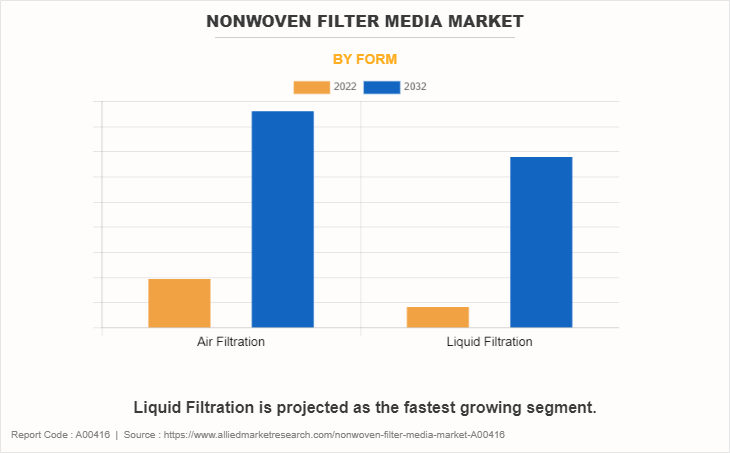
The air filtration segment accounted for the largest share in 2022 accounting for more than half of the global nonwoven filter media market revenue. These specialized materials, composed of synthetic fibers, are highly effective at capturing airborne particles, including dust, allergens, and contaminants. This rise in demand is primarily attributed to growing environmental concerns, stricter air quality regulations, and the need for improved indoor air quality, particularly in industrial, commercial, and residential settings. Nonwoven filter media's versatility, efficiency, and durability make it a preferred choice for addressing air quality issues, and its usage is expected to continue to expand in the coming years.
Liquid filtration is expected to register the highest CAGR of 6.6%. The increasing demand for liquid filtration in nonwoven filter media is driven by a growing need for efficient and environmentally friendly filtration solutions across various industries. Nonwoven filter media offers a cost-effective and sustainable alternative to traditional filtration methods, providing enhanced filtration performance, durability, and adaptability for a wide range of liquid filtration applications. This trend reflects a broader shift towards cleaner and more efficient filtration processes in response to stricter environmental regulations and the pursuit of improved operational efficiency.
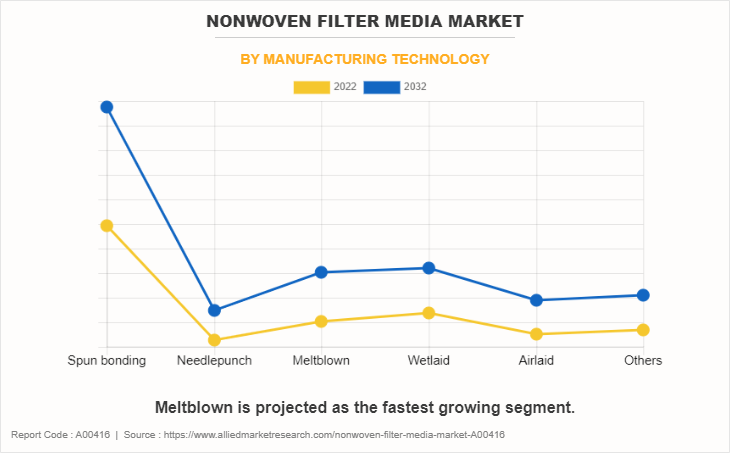
The spun bonding segment accounted for the largest share in 2022 accounting for nearly two-fifths of the global nonwoven filter media market revenue. The increasing demand for spun-bond nonwoven filter media can be attributed to its superior filtration efficiency, durability, and versatility in various industries such as healthcare, automotive, and environmental applications. Spun bond nonwoven materials offer a cost-effective solution for filtering particulate matter, contaminants, and pathogens, making them an essential component in meeting growing filtration needs.
Meltblown is expected to register the highest CAGR of 7.3%. The demand for meltblown nonwoven filter media is steadily rising due to its versatile applications in air and liquid filtration. Industries like healthcare, automotive, and environmental protection are increasingly relying on this highly efficient and cost-effective material to enhance filtration performance, improve air quality, and reduce environmental impact. As concerns for health and sustainability grow, the demand for meltblown nonwoven filter media is expected to continue its upward trajectory.
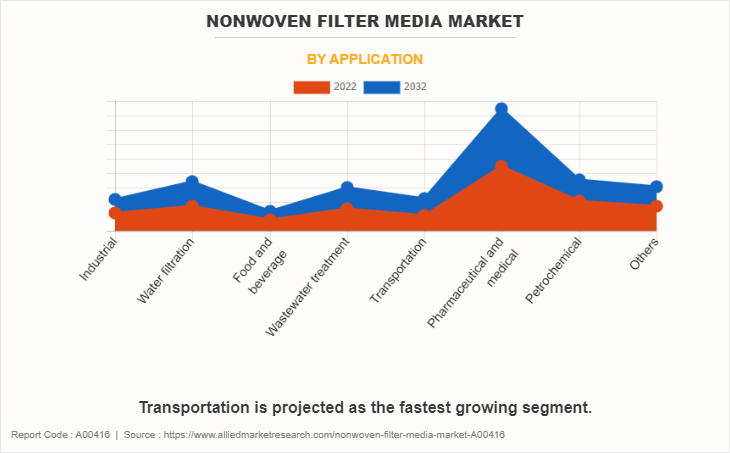
The pharmaceutical and medical segment accounted for the largest share in 2022 accounting for more than one-fourth of the global nonwoven filter media market revenue. The pharmaceutical and medical industries are experiencing a growing demand for nonwoven filter media. These materials are favored for their exceptional filtration efficiency, versatility, and cost-effectiveness. They play a vital role in applications such as sterile filtration, air and liquid purification, and drug delivery systems, meeting the increasingly stringent quality and safety requirements in these sectors. This heightened demand for nonwoven filter media underscores their pivotal role in ensuring the integrity and effectiveness of pharmaceutical and medical processes.
Transportation is expected to register the highest CAGR of 7.5%. Nonwoven filter materials are increasingly favored for automotive, aviation, and rail applications, as they efficiently trap particulate matter, improve air quality, and enhance engine performance, ultimately extending the lifespan of critical components and reducing maintenance costs. This surge in demand is driven by stringent environmental regulations, an increased focus on passenger and crew health, and the pursuit of higher efficiency and sustainability in transportation systems.
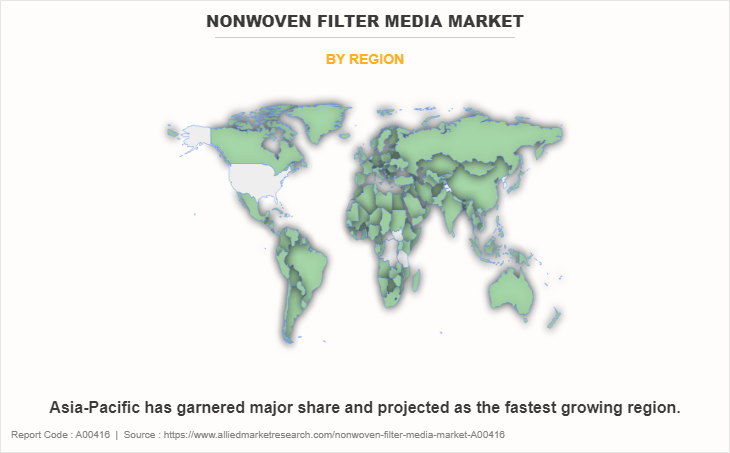
Asia-Pacific garnered the largest share in 2022 accounting for more than one-third of the global nonwoven filter media market revenue. The Asia-Pacific region is experiencing a significant surge in demand for nonwoven filter media. This increase can be attributed to growing industrial and environmental concerns, particularly in countries like China and India. Nonwoven filter media are being extensively utilized in air and liquid filtration applications due to their efficiency and durability, addressing the region's pressing filtration needs.
The major players operating in the global nonwoven filter media market are 3M, Johns Manville, Sandler AG, Berry Global Inc, Kimberly-Clark Worldwide, Inc, Park Industries, Glatfelter Corporation, Ahlstrom, Alkegen and Fitesa S.A. and Affiliates.
Other players include DuPont, Fibertex Nonwovens, Lydall Performance Materials, Hengst SE & Co. KG, Freudenberg Filtration Technologies, Sefar AG, Asahi Kasei Corporation, and Procter & Gamble.
Market Trends:
The development of high-efficiency filters is anticipated to be a significant market trend for nonwoven filter media during the forecast period, with a positive impact on the industry.
Freudenberg Filtration Technologies GmbH and Co. KG provide filter products that, depending on the application, conserve additional space and money while maintaining a lengthy service life.
SinTexx Plus, a corrugated polyester filter media featuring a nanofiber layer, effectively captures dust particles embedded in fine haze generated during coating, cutting, and welding operations. In addition, it filters dust that is challenging to manipulate.
Ahlstrom-Munksjo Oyj provides ultra-low particulate air and high-efficiency particulate air filter media. The air pollution control system portfolio of the organization comprises conductive filters manufactured by CellTech APC, Nano APC, and StatGuard.
In addition to utilizing sophisticated self-cleaning technology, the construction of advanced filters, such as ultra-flow baghouse filters, inflates the filter bags with forceful reverse blasts of compressed air. This causes the dust cake to descend from the bag and into the hopper.
The advancement and enhanced performance of filters will generate fresh avenues for investment for suppliers of nonwoven filter media, thereby stimulating market expansion.
Public Policies:
Environmental Regulations: Environmental regulations are a significant driver for the nonwoven media filter market. Regulatory bodies like the Environmental Protection Agency (EPA) in the U.S. and Environment and Climate Change Canada have set emissions and pollution control standards that require various industries to use filtration systems. Stricter regulations can create a higher demand for more efficient and advanced nonwoven filter media.
Air Quality Standards: Policies related to air quality, such as the Clean Air Act in the U.S., have an impact on the demand for nonwoven filter media. Stricter air quality standards can lead to increased demand for filtration systems in industrial and commercial applications.
Waste Management and Recycling: European Union member states have been actively promoting waste reduction and recycling. Regulations on the disposal of nonwoven filters are designed to encourage recycling and responsible disposal practices.
Health and Safety Standards: Occupational health and safety standards, enforced by agencies like the Occupational Safety and Health Administration (OSHA) in the U.S., can influence the use of nonwoven media filters in workplaces to protect workers from airborne hazards.
Healthcare Regulations: In the context of healthcare, regulatory agencies like the Food and Drug Administration (FDA) in the U.S. have standards for filtration products used in medical settings. Compliance with these standards is essential for manufacturers in the healthcare sector.
Government Procurement Policies: Government agencies at various levels may have procurement policies that encourage or mandate the use of certain filtration technologies, including nonwoven media filters, in public projects and facilities.
Energy Efficiency Incentives: Some jurisdictions offer incentives and tax credits to encourage the adoption of energy-efficient filtration systems, which can drive the demand for nonwoven filter media with high efficiency.
Trade and Tariffs: Trade policies, including tariffs and trade agreements, can affect the availability and cost of nonwoven filter media in North America. Changes in trade policies can impact on the competitiveness of domestic and international suppliers.
Impact Of Russia Ukraine War On the Nonwoven Filter Media Market:
The Russia-Ukraine war can have various indirect and direct impacts on the nonwoven media filter market. Nonwoven media filters are used in a wide range of industries, including automotive, healthcare, industrial, and more.
Russia and Ukraine are significant producers and suppliers of various raw materials, including polymers and textiles, which are essential in the production of nonwoven media filters. Any disruptions in the supply chain due to the war can lead to shortages and increased costs for these materials, affecting the production of nonwoven media filters.
Geopolitical tensions and conflicts can lead to fluctuations in commodity prices, including those related to petrochemicals and polymers. These price fluctuations can impact the cost of manufacturing nonwoven media filters and may result in increased prices for end-users.
Trade disruptions, sanctions, or export restrictions imposed on Russia and Ukraine can limit the export of nonwoven media filters to these countries and potentially disrupt existing supply contracts.
Conflict and geopolitical instability can create uncertainties in the global business environment. Companies may be hesitant to make long-term investments or expand operations in regions affected by the conflict, which can affect market growth.
On the other hand, certain industries, such as healthcare and defense, may experience increased demand for nonwoven media filters due to the need for medical supplies and protective equipment in crisis situations. This can create opportunities for filter manufacturers, but it may be short-lived and specific to certain regions.
Economic downturns and currency devaluation in conflict-affected regions can impact the purchasing power and demand for various products, including nonwoven media filters.
Companies in the nonwoven media filter market may consider relocating or diversifying their production facilities to reduce exposure to geopolitical risks. This could lead to changes in the geographical distribution of manufacturing, impacting supply chains.
In response to changing market dynamics, companies may invest more in R&D to find alternative materials or improve the efficiency of nonwoven media filters.
Key Benefits For Stakeholders
- This report provides a quantitative analysis of the market segments, current trends, estimations, and dynamics of the nonwoven filter media market analysis from 2022 to 2032 to identify the prevailing nonwoven filter media market opportunities.
- The market research is offered along with information related to key drivers, restraints, and opportunities.
- Porter's five forces analysis highlights the potency of buyers and suppliers to enable stakeholders make profit-oriented business decisions and strengthen their supplier-buyer network.
- In-depth analysis of the nonwoven filter media market segmentation assists to determine the prevailing market opportunities.
- Major countries in each region are mapped according to their revenue contribution to the global market.
- Market player positioning facilitates benchmarking and provides a clear understanding of the present position of the market players.
- The report includes the analysis of the regional as well as global nonwoven filter media market trends, key players, market segments, application areas, and market growth strategies.
Nonwoven Filter Media Market Report Highlights
| Aspects | Details |
| Market Size By 2032 | USD 13.7 billion |
| Growth Rate | CAGR of 6.5% |
| Forecast period | 2022 - 2032 |
| Report Pages | 450 |
| By Form |
|
| By Manufacturing Technology |
|
| By Application |
|
| By Region |
|
| Key Market Players | Park Industries., Kimberly-Clark Corporation, Alkegen, Fitesa S.A. and Affiliates, Glatfelter Corporation, 3M, Johns Manville, Sandler AG, Berry Global Inc., Ahlstrom |
Analyst Review
According to the insights of the CXOs of leading companies, the nonwoven filter media market is witnessing a surge in demand due to its indispensable role in addressing pressing environmental concerns. Stricter environmental regulations and a growing consciousness about air and water quality are propelling the adoption of nonwoven filter media across various industries. In addition, the COVID-19 pandemic has boosted the demand for nonwoven filter media in the production of face masks and personal protective equipment, further bolstering the market.
However, the nonwoven filter media market faced a challenge in the volatility in raw material prices, primarily polypropylene, which is a key component in nonwoven filter media production. This price fluctuation can impact manufacturing costs and pricing strategies, potentially limiting market growth. Moreover, while nonwoven filter media offer several advantages such as efficiency and versatility, they face competition from alternative filtration technologies, which may hinder their widespread adoption.
The CXOs further added that with the advancements in technology, there is a growing trend towards the development of high-performance nonwoven filter media with enhanced filtration efficiency and durability. This offers opportunities to the market for innovation and product differentiation, attracting customers seeking superior filtration solutions. Furthermore, the rising demand for nonwoven filter media in emerging economies, driven by industrial expansion and increased awareness of pollution control, provides a promising growth avenue for market players.
The global nonwoven filter media market was valued at $7.4 billion in 2022, and is projected to reach $13.7 billion by 2032, growing at a CAGR of 6.5% from 2023 to 2032.
Nonwoven Filter Media Market is studied across North America, Europe, Asia-Pacific, and LAMEA.
Asia-Pacific is the largest regional market for Nonwoven Filter Media.
Transportation is the leading application of Nonwoven Filter Media Market.
3M, Johns Manville, Sandler AG, Berry Global Inc, Kimberly-Clark Worldwide, Inc, Park Industries, Glatfelter Corporation, Ahlstrom, Alkegen and Fitesa S.A. and Affiliates are the top companies to hold the market share in Nonwoven Filter Media.
Rising consumer awareness regarding water and air pollution is the upcoming trend of Nonwoven Filter Media Market in the world.
Increasing demand for water filtration and growth in HVAC systems are the driving factor of the Nonwoven Filter Media Market.
Loading Table Of Content...
Loading Research Methodology...


